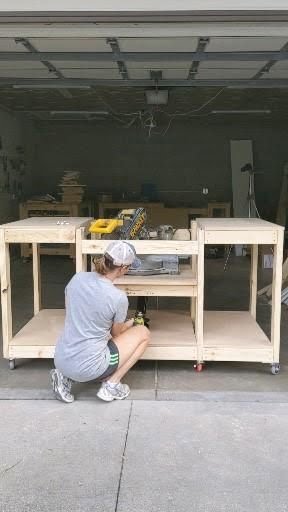Introduction
Woodworking, like many other crafting and fabrication fields, involves the use of precise measurements to ensure the desired outcome. The challenge of this type of work is that every project often varies from the last one and careful calculations are needed to create a successful result. That’s why having a design program specific for woodworking can be incredibly beneficial.
A woodworking design program would allow for accurate measurements on the type of project being done, as well as tracking necessary resources and inventory, organization for future projects, and better management of tools available. Having such a program also offers a convenient and quick way of assembling certain diagrams or plans that could otherwise become very confusing with manual drawings. With specific templates easily accessible from a woodworking design program, it can save time in setting up future projects by not requiring any effort towards redrawing each diagram. Furthermore, such programs provide various views regarding cut materials employed in a given job which will help both experienced craftsmen find more efficient ways to improve their projects, as well as beginners getting into the field gain some insight into proper execution.
With all these advantages in mind and construction processes becoming more defined over time, it makes sense to adjust and implementing new technologies that can assist in the production process. As seen with most other industries mostly relying on CAD programs today, using software dedicated solely to woodworking could be yet another valuable tool when carrying out creative pieces along with normal furniture designs; maximizing productivity while optimizing accuracy along the way
Types of Design Programs
CAD Software – CAD, or Computer Aided Design software, is the most popular and widely used woodworking design program, because of its affordability and easy learning curve. CAD typically comes with a variety of 2D design tools, including drafting tools for drawing plans, as well as circle and rectangular layout tools. CAD can also be used to export vectorized drawings into other formats for professional use.
3D Design Tools – 3D design tools are the new generation of woodworking design programs that offer more visual capabilities than traditional CAD software. It has capabilities such as 3D modeling from scratch or premade models, adding textures and materials to models, real-time coloring and shading simulations, advanced rendering to show realistic light effects, animating movements associated with your model-based designs.
Computer Numerical Control (CNC) Design Programs – If you want to create complex parts that require multiple stages of machining and cutting using CNC machinery then CNC computer programs are designed specifically for this purpose. These programs allow you to easily create designs that can be directly imported into CNC machines which will run the cuts automatically ensuring accuracy in each pass while enabling quicker production times than manual tools could achieve.
Examples of Projects Completed Using Design Programs
Examples of projects that have been completed with design programs for woodworking can include items such as furniture, toys, decorative items, boxes and vases. Design programs can be used to create custom designs for any type of woodworking project imaginable. Many complex shapes or intricate details created in one program are easily transferable to a computer numerical control (CNC) machine, potentially making a difficult job much easier to complete. Examples of furniture created using design programs include chairs, tables, desks, cabinets and bed frames. Toys made using design programs typically involve more complex shapes and unique details than most other woodworking projects, such as cartoon characters or models of famous monuments. Using a design program helps ensure the accuracy of the final product when making items like these. Decorative items such as picture frames and fireplace mantels often utilize 3-dimensional shapes with detailed edging which can be quickly generated using a design program. Simple boxes with curves around the edges or vases with complicated sculptures all look great when crafted using design programs due to the precision levels they allow for.
Benefits of Using Design Programs for Woodworking
Design programs for woodworking can be an invaluable resource for hobbyists, professionals, and entrepreneurs alike. With these programs, users can create stunning designs without having to hire a professional or use complicated tools. They offer time and cost saving advantages that make using them a must-have resource in any woodshop.
First of all, design programs allow woodworkers to visualize their projects before they purchase or cut materials. With these programs, users can determine the size of boards they need to purchase (if applicable) as well as the potential difficulty of the project”all without having to guess at what traditional measurements are required. As a result, users can reduce material waste and save money by more accurately purchasing exactly what is needed for their project.
Design programs also help to eliminate costly mistakes throughout the course of a project. Instead of manually measuring each board multiple times throughout the construction process and relying only on visual inspection during assembly, users can ensure that boards are cut properly “and just the way the plan calls for”without much effort at all. This saves both time and materials that could potentially lead to costly repairs down the road should something break because it wasn’t built correctly from the start.
Finally, design programs help increase efficiency by removing tedious math equations from woodworking projects while increasing accuracy in measurement. Complex calculations such as millimeter differences between boards and degree conversions have been automated by these programs so that users no longer have to rely on manual calculations that take considerable time away from actually building projects. Plus, with access to pre-made designs and plans available within some programs (depending on which one you choose), you’ll save even more time getting started on projects right away without having to go through lengthy planning sessions prior to beginning construction work.
Reviews of Design Programs for Woodworking
Design programs for woodworking are an invaluable resource for woodworking professionals and hobbyists alike. By leveraging CAD (Computer Aided Design) technology, intricate plans can be easily created and shared with others suitable to their level of skill. Many online programs offer step-by-step instructions on how to build custom furniture or cabinetry, or a wide variety of other projects. Most programs come with customer feedback so that users can accurately assess the quality of program before committing to purchase.
The design software enables users to quickly and easily create 3D models without having a background in engineering or drafting. This allows them to accurately visualize complex angles, curves, and profiles while they work on their projects. The software also provides a range of options like ready-made templates, parts lists, cut list summaries, material requirements lists and more to make the entire process simpler.
Reviews from customers typically cover topics like ease of use; quality/accuracy of produced designs; accuracy/usefulness of diagrams; customer service and technical support; export capabilities; compatibility with CAD tools; and cost effectiveness. Reviews often contain detailed information about how intuitive the program is to use, what features it contains and whether it would be suitable for their particular project needs. Additionally, customer reviews may address additional features such as importing existing designs from another application and the ability to modify already existing objects within the program itself.
Overall, design programs for woodworking are highly beneficial pieces of software that allow both professional craftsmen and DIYers alike to bring their creations into reality in an efficient manner without having experience in engineering or drafting fundamentals. Customer reviews provide an incredibly valuable resource which can save time as well as money when choosing a CAD tool suitable for individual working needs.
Tips to Enhance Design Programs for Woodworking
1. Practice using the software on sample projects before attempting a large project: Instead of jumping in and beginning your first project on unfamiliar software, practice first by starting small sample projects and testing out different features and tools. Working through potential problems in advance will save you time and frustration down the line.
2. Read up about new features: Keep up to date with the latest news about design program updates that may include new features or helpful tools for woodworking projects. Understanding how a subscription version can benefit you is important in actively taking advantage of its full potential.
3. Take advantage of tutorials and user manuals: Learning from other users’ experiences can be helpful as well as reading user manuals that typically contain walk-throughs on how to use specific parts of the program (this is especially important if you never used similar software before). Watching interactive tutorials online can help acquaint you with the different functions in a more hands-on way.
4. Make sure your computeralso has appropriate specs: If your computer isn’t powerful enough, it can limit capabilities within a design program for woodworking such as render speeds or heavy calculation processing. Check out minimum system requirements for the given software to ensure that your computer is up to par with all processes needed for successful operation of the program.
5. Use templates provided with vendor software when just starting out: Templates can help you learn more quickly by providing an example-based approach that makes it easier to understand how each command works inside the program while generating adequate results in an efficient manner
Conclusion
Design programs for woodworking can be incredibly useful for both experienced and novice carpenters alike. These programs allow users to more accurately plan for their projects, including measurements, cuts, and other details. Furthermore, the user-friendly interfaces of most design programs allow users to quickly familiarize themselves with the tools necessary to optimize their designs. Design programs also help minimize waste during a project, as they can provide the exact plans and measurements needed in order to ensure accuracy and precision. In addition, design programs can help save money by eliminating costly mistakes that could arise from manual calculations or incorrect measurements. By utilizing these design programs, woodworkers might find increased efficiency in new projects or existing ones. It is clear that design programs are essential tools for any serious carpentry project and should be considered as such when it comes time to plan a carpentry endeavor.

Hi everyone! I’m a woodworker and blogger, and this is my woodworking blog. In my blog, I share tips and tricks for woodworkers of all skill levels, as well as project ideas that you can try yourself.





